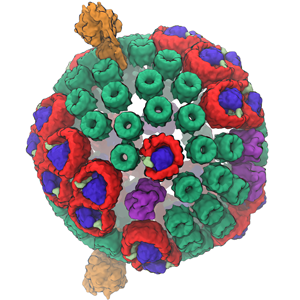 Spring 2016 MWF 2:05-2:55
Spring 2016 MWF 2:05-2:55
Howey S204
Instructor: JC Gumbart
Office: Howey W202
Phone: 404-385-0797
Email: gumbart at physics.gatech.edu
Office Hours (by appointment or whenever you catch me!)
Overview
This course will introduce how physical concepts can be used to gain insight into the working of biological systems at a molecular level. The material will pull from all areas of physics, but particularly classical and statistical mechanics, with a bit of EM and QM thrown in. While the mathematics is not onerous, students should feel comfortable with simple matrix and differential equations as well as plotting and manipulating data. Finally, no prior knowledge of biology is required – just a desire to learn a different way of thinking about complex systems!
Learning Goals
After completion of this course, students will be able to (1) read and understand molecular biophysics papers, (2) analyze data from experiments and simulations, (3) design a testable model of a biophysical phenomenon or system, including writing code for modeling and/or analysis, and (4) communicate their results, both orally and in writing.
Textbooks
Physical Biology of the Cell by Phillips, Kondev & Theriot, 2nd edition (recommended)
Physical Models of Living Systems, Philip Nelson, 1st edition (suggested)
- Class Participation (10%): Students are to be expected to attend all classes and actively participate. A significant amount of learning will come from the discussions in class. The instructor will note class participation and count it toward the final grade. Extensive use of mobile devices will result in losing credit for that day. Up to two absences will be excused without penalty.
- Homework (50%; 40% for graduate students): Approximately 6-8 homework sets with problems involving visualization and analysis of biological structures with the program VMD as well as calculations using equations derived in class. Homework will be turned at the beginning of class on the due date. Late homework will be accepted with a 10% penalty for one extra day, 25% penalty for two extra days. Extensions may be granted under specific extenuating circumstances, negotiated in advance.
- Papers (10%): The ability to critically read and digest the scientific literature is a skill that has to be learned. Therefore, we will read five biophysics papers and devote a class day to discussing each. Before we discuss them in class, you will write a one-page critique of the paper and turn it in at the beginning of class. The critiques will be scored as 1, 0.5 or 0. If your critique clearly demonstrates that you have read the paper, you will get a 1. If you copy abstract/summary or other parts of the paper, you will get a zero. If you have read the paper but completely missed the point, you will get a 0.5. Missing critique will be scored as zeros. No late critiques will be accepted.
- Project (30%; 40% for graduate students): In the second half of the term, you will have to carry out a project in which you model a chosen biophysical phenomenon or system. The basis for this project will either be a well-known phenomenon (e.g., propagation of neural excitations) or an experimental paper on a particular protein. In the former case, you will have to design and implement a mathematical model in code, with which you can produce and analyze output for comparison with real data. In the latter case, you will determine a pertinent question about the protein and design a set of molecular dynamics simulations to answer it, including coding your own analysis scripts using VMD. You will have to present the project to the class as well as in a paper to be turned in during finals week. This paper will need to be in a form suitable for publication, with specific formatting provided in class.
Schedule (very approximate!)
- Week 1, 1/11, 1/13, 1/15: introduction to biology: messy, hot, and crowded visualization with VMD, four classes of biomolecules. Stat mech.
- 2, 1/20 (same lecture notes), 1/22 (canceled due to weather): stat mech, randomness, and distributions
- 3, 1/25, 1/27, 1/29: discuss Paper 1; amino acid properties, pKas
- 4, 2/1, 2/3, 2/5: polymer theory, FJC/WLC models; DNA/RNA structure, bending/packing
- 5, 2/8, 2/10, 2/12: protein folding; electrostatics
- 6, 2/15, 2/17, 2/19: discuss Paper 2; diffusion
- 7, 2/22, 2/24, 2/26: crowding; gene structure, mutation, bioinformatics; discuss class projects
- 8, 2/29, 3/2, 3/4: membranes, curvature; chemical equilibrium, rate equations
- 9, 3/7, 3/9, 3/11: discuss Paper 3; rate equations (cont.), cytoskeleton
- 10, 3/14, 3/16, 3/18: molecular motors (e.g, ATP synthase, kinesin/myosin)
- (SPRING BREAK)
- 11, 3/28, 3/30, 4/1: discuss Paper 4; bioelectricity (ion channels, Nerst potential, Hodgkin-Huxley model, etc.)
- 12, 4/4, 4/6, 4/8: central dogma, genetic code; gene regulation; QM in biology (photosynthesis, excitation transfer, etc.)
- 13, 4/11, 4/13, 4/15: discuss Paper 5; PRESENTATIONS
- 14, 4/18, 4/20, 4/22: PRESENTATIONS
- 15, 4/25: PRESENTATIONS
